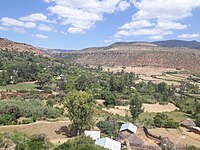Irrigation environmental impacts

Imagine you have a garden full of plants and you want to give them water to help them grow. You have a hosepipe that you can use to water the plants but you also want to make sure that the water doesn't go to waste and also doesn't harm the environment around the garden.
When farmers grow crops on a larger scale, they need to use a lot more water to feed their crops. They use a method called irrigation, which is like giving the crops a shower of water using a big sprinkler system or dug out channels called canals from nearby rivers. This helps the crops to grow and be healthy but it can also have some negative impacts on the environment.
If too much water is used for irrigation, it can cause the soil to become waterlogged, which means the roots of the plants can't breathe and they may die. This could also cause soil erosion, which can lead to the soil being washed away and causing damage to the environment like plant and animal habitats. Also, if the water being used for irrigation has chemicals or fertilizers in it, it could pollute nearby streams and rivers which can harm aquatic animals and plants.
Another environmental impact of irrigation can be the depletion of underground water sources, which are called aquifers. The overuse of irrigation can make these underground water sources run out, which could lead to droughts or water scarcity in the nearby community.
To summarize, irrigation is like giving plants a shower of water to help them grow, but if too much water is used or if the water used is polluted, it can harm both the plants and the environment around them. Therefore, it is important to use irrigation systems cautiously and be mindful of the environmental impacts they can have.
When farmers grow crops on a larger scale, they need to use a lot more water to feed their crops. They use a method called irrigation, which is like giving the crops a shower of water using a big sprinkler system or dug out channels called canals from nearby rivers. This helps the crops to grow and be healthy but it can also have some negative impacts on the environment.
If too much water is used for irrigation, it can cause the soil to become waterlogged, which means the roots of the plants can't breathe and they may die. This could also cause soil erosion, which can lead to the soil being washed away and causing damage to the environment like plant and animal habitats. Also, if the water being used for irrigation has chemicals or fertilizers in it, it could pollute nearby streams and rivers which can harm aquatic animals and plants.
Another environmental impact of irrigation can be the depletion of underground water sources, which are called aquifers. The overuse of irrigation can make these underground water sources run out, which could lead to droughts or water scarcity in the nearby community.
To summarize, irrigation is like giving plants a shower of water to help them grow, but if too much water is used or if the water used is polluted, it can harm both the plants and the environment around them. Therefore, it is important to use irrigation systems cautiously and be mindful of the environmental impacts they can have.
Related topics others have asked about:
